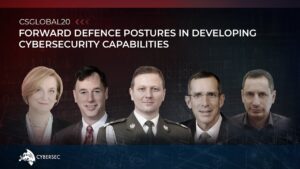
On the second day of the CYBERSEC Global 2020 virtual conference, the Defence Stream organized by the NATO Counter Intelligence Centre of Excellence explored a number of defence-related topics.
 The Defence Stream was opened by Annegret Kramp-Karrenbauer, Germany’s Federal Minister of Defence. The minister summarized European Union plans to maintain digital sovereignty based on five plans of action: (1) Use trustworthy technology from various manufacturers; (2) Build up key technologies; (3) Maintain core command and control capabilities; (4) Increase innovation capabilities; and (5) Promote digital consequences.
The Defence Stream was opened by Annegret Kramp-Karrenbauer, Germany’s Federal Minister of Defence. The minister summarized European Union plans to maintain digital sovereignty based on five plans of action: (1) Use trustworthy technology from various manufacturers; (2) Build up key technologies; (3) Maintain core command and control capabilities; (4) Increase innovation capabilities; and (5) Promote digital consequences.
 5G is an exceptional technology not only for business but also for modern battlegrounds. Riho Terras–European Parliament member and former Commander of the Estonian Defence Forces–pointed out that, in the past, new technologies originated from military research and development, and were later adapted and spread among the general population. More recently, though, technologies developed since the Internet have worked the other way around. This situation poses challenges for 5G to enable technologies such as Artificial Intelligence, Virtual and Augmented Realities, and Autonomous Weapons for battleground applications. There are also security concerns because commercial developers did not design technologies according to military standards, wherein adversary actions to compromise, disable, or destroy are assumed. The potential benefits to defence forces generally outweigh the challenges of using 5G; however, the technology needs to be better secured before it can be fully integrated with strategic infrastructure. End-users of 5G services can benefit from these accommodations which will lead to improved privacy and security levels, building trust in the technology.
5G is an exceptional technology not only for business but also for modern battlegrounds. Riho Terras–European Parliament member and former Commander of the Estonian Defence Forces–pointed out that, in the past, new technologies originated from military research and development, and were later adapted and spread among the general population. More recently, though, technologies developed since the Internet have worked the other way around. This situation poses challenges for 5G to enable technologies such as Artificial Intelligence, Virtual and Augmented Realities, and Autonomous Weapons for battleground applications. There are also security concerns because commercial developers did not design technologies according to military standards, wherein adversary actions to compromise, disable, or destroy are assumed. The potential benefits to defence forces generally outweigh the challenges of using 5G; however, the technology needs to be better secured before it can be fully integrated with strategic infrastructure. End-users of 5G services can benefit from these accommodations which will lead to improved privacy and security levels, building trust in the technology.
 Some ways to lead modern conflicts are as old as information warfare–whoever knows more on the battlefield gains advantage. This old idea is exploited in a new manner today, using the open character of social media to spread misinformation and effectively create circumstances to suit one’s agenda. The stream’s highlight was the “Information Warfare – Exploitation of History, Religion, and Economics in Cyberspace” panel with Deputy Prime Minister and Minister of Defence of the Republic of Latvia, Artis Pabriks, and the Defence Minister of Slovakia, Jaroslav Naď.
Some ways to lead modern conflicts are as old as information warfare–whoever knows more on the battlefield gains advantage. This old idea is exploited in a new manner today, using the open character of social media to spread misinformation and effectively create circumstances to suit one’s agenda. The stream’s highlight was the “Information Warfare – Exploitation of History, Religion, and Economics in Cyberspace” panel with Deputy Prime Minister and Minister of Defence of the Republic of Latvia, Artis Pabriks, and the Defence Minister of Slovakia, Jaroslav Naď.
Minister Pabriks stressed that information operations have always been part of war efforts. Still, today there is new weapon available for waging information warfare: “Although modern social media may become a weapon, modern society still looks at war in terms of the past. Today, although we cannot speak of an active war, there is a constant struggle for users in the social environment. Russia uses it to create media channels such as the ‘First Baltic Channel’ and ‘Russia Today,’ helping it create a narrative that the Western world has failed. The role of social media is also evident in the Nagorno-Karabakh conflict, in which both sides actively use the media as a weapon.”
According to Minister Naď, the social media sphere has turned into a global battlefield. “This technology has brought unimaginable comfort to people. Thanks to them, a lot of very important issues have become far more simple. However, the dark side of this technology is that it allows the easy spread of disinformation, with social media channels being the most common platform/instrument for spreading it,” said the Slovak minister. In this context, Minister Naď stressed that NATO countries should not spread disinformation as a weapon. The job of disinformation is to raise doubts that will ultimately make everything unbelievable. The challenge, then, is to fight disinformation, not to spread more of it.

The 2016 US presidential election brought the challenges of “fake news” to the forefront. Many actions have been undertaken to prevent false information from spreading by bringing together stakeholders from governments, tech giants, and other parties involved. Effective rapid identification and blocking of fake news allows nations to contain information warfare and limit state-wide effects, preventing adversaries from manipulating social moods. Nations must resist the temptation to suppress “inconvenient” news by labeling it as fake, however, otherwise the free flow of information and ideas will be crushed.
 What’s ahead? We may already be looking at the technology that will become the future military game-changers. Bob Wells, Chief Scientist at NATO, thinks machine learning, big data, automation, and robotics will shape future arms. However, NATO must discover the correct combinations of technologies and roles to unleash their maximum potential. The key to these discoveries will be NATO’s research team, which gathers over 500 of the world’s best scientists from 18 out of 20 top universities.
What’s ahead? We may already be looking at the technology that will become the future military game-changers. Bob Wells, Chief Scientist at NATO, thinks machine learning, big data, automation, and robotics will shape future arms. However, NATO must discover the correct combinations of technologies and roles to unleash their maximum potential. The key to these discoveries will be NATO’s research team, which gathers over 500 of the world’s best scientists from 18 out of 20 top universities.
 NATO recognized cyberspace as an operational domain in 2016, and in 2019 the Alliance added outer space to the list. This is a vivid example of the pace at which modern warfare is evolving and what it will reach. There may be similar patterns in the approaches to cyberspace and outer space. Just as we needed to find a way for international cooperation on exploring the unknown (outer space), we need to find a set of rules for navigating cyberspace. As Ambassador Sorin Ducaru, Director of EU SatCen, explained, the two domains are linked together because assets in outer space rely on computers processing high volumes of data. This is why enhancing cybersecurity must be a global effort to secure our states, businesses, outer space, and whatever else might be ahead of us.
NATO recognized cyberspace as an operational domain in 2016, and in 2019 the Alliance added outer space to the list. This is a vivid example of the pace at which modern warfare is evolving and what it will reach. There may be similar patterns in the approaches to cyberspace and outer space. Just as we needed to find a way for international cooperation on exploring the unknown (outer space), we need to find a set of rules for navigating cyberspace. As Ambassador Sorin Ducaru, Director of EU SatCen, explained, the two domains are linked together because assets in outer space rely on computers processing high volumes of data. This is why enhancing cybersecurity must be a global effort to secure our states, businesses, outer space, and whatever else might be ahead of us.
The NATO Counter Intelligence Centre of Excellence was the Main Institutional Partner of CYBERSEC Global 2020, and was responsible for organization of the Defence Stream.
Watch the Defence Stream:
- DEFENCE STREAM KEYNOTE
- Military use of 5G technology.
- Information warfare – exploitation of history, religion, and economics in cyberspace.
- At the forefront of innovation – NATO’s approach towards science & technology.
- Forward defence postures in developing cybersecurity capabilities.
- Cybersecurity of outer space – exploring the unexplored.